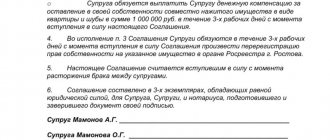Spouses divorcing their marriage are immersed in the process of dividing property and resolving other disputes (place of residence of common children, payment of alimony). Not only common property, but also debt obligations are subject to division. According to the principle of equality of shares, it would not be fair to pay the loan to only one person, given that the money was spent on the needs of the family. The share of debt is determined by drawing up a voluntary agreement or going to court. To avoid paying a large state fee, lawyers advise resolving the issue peacefully and limiting yourself to the first option.
Definition of the concept of “debt obligations of spouses”
The word “debt” refers to the existence of financial obligations.
Banks and other credit organizations issue funds for certain purposes. Debt can arise both to government bodies, for example, in case of non-payment of fines, and to ordinary citizens who provide a certain amount for a period pre-specified in the receipt. During a divorce, joint loans or financial obligations assumed by one spouse with the consent of the other will be divided in half. The moment is regulated by Article 39 of the Family Code. The only condition for equal division is that the funds be spent exclusively on the needs of the family. If the loan obligations according to the documents are only on the husband or wife, then the following points become clear:
- The size of the family budget.
- The moment one of the spouses acquires expensive property.
- Determination of acquisition cost.
- Comparison of the price of the property received with the income of the spouses and the size of the loan.
- Finding out the date of taking out debt obligations.
If the money is spent exclusively on the needs of one spouse, then the second will have to prove the inappropriateness of dividing loan obligations. The grounds for refusal to divide the debts of a wife or husband during a divorce are usually the following:
- The spouse pays punitive damages that are not subject to division.
- The money was spent by the husband or wife for their own personal purposes.
- The loan was issued secretly from the second spouse.
- The loan was taken by a man or woman before marriage.
- Funds withdrawn from the credit card of one of the spouses. Formally, a husband or wife has the right to prove that the money was spent on the needs of the family, but in practice this is rarely possible.
Division by court
Next, you should find out how disputed loan debts are divided during a divorce. If the divorced couple cannot reach an agreement peacefully, only the court can resolve the conflict. One of the parties files a claim. The arbitrator initially determines the legality of the loan transaction and the purpose for spending the funds. In order for citizens to participate in the loan repayment, the fact of joint participation in these finances must be proven.
Sometimes judicial intervention is necessary to separate debt obligations.
In practice, very often the plaintiff is not able to prove that the loan was needed for family needs. Then the judge will recognize the debt as personal and force the individual to pay it off on their own. An interesting situation arises, for example, if a wife owns a car, but borrows money to buy transport for her husband.
Here you can prove the direct connection of the loan being spent not for the needs of the borrower. The court will force the husband to pay off part of the debt and will consider the option of compensating the cost of the car in favor of the woman. If the parties do not agree with the judge's determination, they can appeal to the Supreme Court.
Special cases include disputes over compensation for the debts of a person declared missing. The second spouse will definitely have to sue the debt collector and prove that there is no connection with the existing arrears. If the defaulter dies, the debt will be distributed among close relatives by inheritance law.
Total debt
The total debt of spouses wishing to divorce must be divided in half. The exception is a change in proportion by a court decision or agreement. The list of examples of joint loans is as follows:
- Registration of a mortgage loan.
- A situation where both spouses are co-borrowers, or one of them is a guarantor, and the other is obliged to repay the debt.
- Debt obligations taken out to pay for joint needs: purchase of furniture;
- payment for education or treatment of a common child;
- purchase of household appliances;
- home renovation;
- vacation;
- wedding.
The division of the spouses' debts may not occur if one of them wishes to take away the property encumbered by the loan, and the second has no return. For example, it is easier to give up a car taken shortly before the dissolution of a marriage than to pay the full amount and then sell it.
Court's point of view
In 2020, the debt is recognized by a court decision as joint and is subject to repayment by both spouses in the following cases:
- Both parties to the conflict signed the loan contract or were duly notified of its existence.
- The borrowed capital was spent for general needs or by each participant in the dispute in equal shares at his personal discretion.
The fact of using a loan for family needs can be proven by purchase and sale agreements concluded in temporary proximity to the day the money was received from the bank. Also, confirmation for the court will be receipts for the purchase of household appliances, furniture, and payment for services. An additional argument will be a certificate of the amount of income of citizens and the value of the acquired property.
The court refuses to satisfy claims against the former spouse if the obligation has a direct connection with the personality of the debtor. For example, fines for violating traffic rules, administrative penalties, harm caused to the life, health, and property of other persons. Similar rules apply to loans received before marriage, as well as those spent on maintaining an individual’s personal property.
Personal debt
Loans issued to one of the spouses without the consent of the other are considered personal. For example, the wife will not have to pay the husband’s debts during a divorce if the money was taken and spent for purposes not related to improving the family’s standard of living. Such issues are regulated by Article 45 of the RF IC. The division of debts between spouses does not occur if they arose at the time of termination of family life.
It is enough for a husband or wife to prove to the court that taking on credit obligations was the personal initiative of the debtor who no longer lives with his family.
Fictitious debt when dividing property
To reduce the share of the other party in the common property, some unscrupulous spouses use such a prohibited technique as creating a “fictitious debt.” For example, a husband or wife in collusion draws up a loan agreement retroactively, and indicates general needs as the purpose of receipt.
What is fictitious debt and how is it distributed between spouses during a divorce?
In this case, the injured party will have to act. Firstly, if a fictitious loan agreement is suspected, it is necessary to insist on an examination in order to determine the period of its actual writing. Secondly, an examination of the financial condition of the married couple at the time of the theoretical loan application may be necessary. Thus, the level of income must be determined in order to determine whether the conditions for obtaining a loan are met.
If the creditor is not a banking structure, then it is necessary to establish the existence of a connection between the “lender” and the second spouse.
If the injured party fails to prove that the loan is fictitious, then the division of debts in 2020 will end with the fact that they will have to answer for them with the common property.
Fictitious debt
A fictitious (false) loan is “taken out” by one of the spouses in order to increase their share in the distribution of property. In court, the fraudster will demand compensation, arguing with false arguments, which can be answered using the methods provided for by law:
- A fictitious loan taken retroactively is refuted by examination. She is appointed by a judge or the other party to the conflict if there is suspicion.
- The spouse's false arguments are also determined by other points that need to be paid to the court's attention: the absence of a demand for repayment of the debt;
- close relationship with the person who issued the loan;
- low income of the citizen who lent funds.
Only witnesses will be liable for perjury. A deceiver cannot be punished for unfounded statements. The situation is completely different when submitting false documents to the court. According to Article 307 of the Criminal Code of the Russian Federation, the spouse faces criminal liability for presenting falsified evidence.
The legislative framework
| Name of the normative act | What does it regulate? |
| Family Code of Russia |
|
| Tax Code of Russia (part 2) |
|
| Civil Procedure Code of Russia |
|
| Review of judicial practice of the Supreme Court of Russia No. 1 for 2016 |
|
Debt division methods
Options for dividing the common debts of spouses are given in Article 45 of the RF IC:
| Type of division | Description |
| In half | During a divorce, they try to divide debts according to the principle of equal shares. Property and loan repayment obligations will be divided equally. |
| Unequal proportions | The spouse who receives a larger share of the property will be required to take on an appropriate amount of debt as compensation. |
| Counting exact shares | Initially, the parties try to divide the acquired property fairly. Then the debts are divided according to the size of the shares of property inherited by the spouses. |
In total, the parties have 2 options for resolving disputes:
- Voluntarily draw up and notarize an agreement on the division of debt obligations.
- Contact the court.
If a married couple has drawn up a prenuptial agreement in advance, then there is no need for litigation and drawing up an agreement. The document indicates the main points of division of property and debt obligations. It is disputed exclusively in court.
Division of debt or credit obligations of spouses according to the law
Content
During division, debts are included in the common property and are divided in proportion to the awarded shares. The specifics of this section are regulated by Ch. 7 RF IC.
Debt obligations are divided into several types:
| View | Include |
| Personal | Loans and other debts issued before marriage or after its dissolution |
| Are common | Loans received during marriage and spent on family needs with the knowledge of the second spouse: mortgage, consumer, etc. |
The greatest number of disputes arise when dividing loans issued during marriage without the knowledge of the second spouse. It is believed that loans in such situations are taken with the consent of the other party (Part 2 of Article 35 of the RF IC). The spouse who did not know about the debt will have to prove that the money was not spent on family needs. But doing this is very problematic.
If the loan was issued before marriage, but after registration the debt was repaid, upon division the second spouse has the right to recover half of what was paid to terminate obligations to the bank.
By joint agreement, the parties can draw up an agreement on the basis of which the debt will be paid by the spouse who took out the loan without the consent of the other party. Otherwise, there is a high probability that the debt will be awarded in proportion to the allocated share in the property through the court, since the interests of a third party – the bank – are also affected here.
Types of debts and features of their division
Debt obligations of citizens are divided into several types:
| View | Features in court | Section by agreement |
| Mortgage. Both spouses act as co-borrowers and bear equal responsibility to the bank | The amount of debt according to the schedule is divided in accordance with the awarded shares or according to a peaceful agreement reached during the proceedings. It is allowed to divide real estate in court followed by division of the loan with the consent of the bank | The parties independently establish the shares and amount of compensation when abandoning part of the real estate. You can also take the bank’s consent to sell the apartment, sell it and use the funds to pay off the debt |
| Consumer loans | Divided equally, no assessment required | Payments are distributed as agreed. The debt may remain with one of the spouses |
| Car loans | The car is not subject to division in kind and remains the property of one spouse. The second one receives compensation for half the cost. The debt here is divided in half. It is allowed to transfer the car into sole ownership without paying compensation, provided that credit obligations remain with the owner | An agreement is drawn up on the basis of which the debt is divided in half or in other parts or remains with one of the spouses |
| Liabilities to third parties (debts on receipts, etc., if there is no collateral) | Divided in half | Divided by agreement |
If we are talking about mortgaged real estate, the bank's consent will be required during division. Based on an agreement between the spouses or a court decision, he must amend the agreement and divide the debt according to the specified shares.
Forms for dividing debt obligations
There are two forms of debt division - going to court or drawing up an agreement with a notary. Both options have the following characteristics:
| Judicially | At the notary |
| The court is guided by the law and independently determines the size of the shares and the amount of debts for each spouse based on the claims and the evidence presented. | The parties have the right to independently determine to whom and what debts will remain. An exception is a mortgage: the consent of the lender will be required here |
If a prenuptial agreement is concluded between the parties, the division is made in accordance with its provisions. If one of the spouses does not agree with the terms of the document, they will have to challenge it in court.
Spouses have the right to draw up a separate agreement on the division of debts with a notary or include this issue in the agreement on the division of common property.
Peaceful resolution of the dispute
It is important for spouses to remember the correct algorithm of actions for a peaceful solution to the problem:
- Come to a conclusion which debts are common and subject to division.
- Agree among themselves on the option for distributing loan obligations.
- Set out the terms of division on paper by drawing up an agreement.
- Have the document certified by a notary.
After certification, the contract is equal to an executive document. If one of the parties does not want to pay, then the second has the right to file a complaint with the court.
Dispute resolution in court
A claim for division of property and debt obligations is filed with the legal authority at the defendant’s place of residence. If the claim value does not exceed 50 thousand rubles, then the magistrate will consider the case. Otherwise, the documents must be presented to the district court office. Before submitting an application, it is advisable to remember certain nuances of such cases:
- You can add a requirement to divorce the spouses to the claim for division of debt obligations.
- The state fee is paid by the initiator of the proceedings.
- The other party to the conflict has the right to file a counterclaim, setting out its demands.
- The statute of limitations for cases of division of debts and property is 3 years from the date of divorce.
When considering a case, the judge acts according to a certain algorithm:
- Selects general debt obligations.
- Determines the value of the shares of property inherited by the spouses.
- Divides joint debts equally.
If the property cannot be divided in half, then the difference will be compensated by the amount of loan obligations. The judge has the right to deviate from the principle of equality of shares only if there are common children. The parent with whom the dependents reside may receive more of the property and less of the debt. You can prove that the funds received under the loan agreement were spent on other needs as follows:
- Describe the situation in the statement of claim.
- Attach evidence to the claim.
- Try to find witnesses who will agree to confirm the words of one of the spouses about spending the borrowed funds on their needs.
The following documents may serve as evidence:
| Reasons for taking out a loan | Supporting documents |
| Payments for education and treatment of common children | • an agreement with an educational institution on payment of money in installments; • loan agreement. |
| Purchasing real estate for the purpose of living or generating income to replenish the family budget | • mortgage; • agreement confirming the purchase of property. |
| Purchasing things to meet the family's household needs | • purchase receipts; • loan agreements. |
Depending on the circumstances, other evidence may be required:
- witness statements;
- audio and video materials;
- correspondence;
- a certificate from a narcologist confirming that the spouse has an addiction.
Based on the evidence presented, the judge will make a decision. The bailiff service will monitor the execution of the verdict.
Court decision on the division of debt obligations No. 2-1541/2017 ~ M-1028/2017
SOLUTION
IN THE NAME OF THE RUSSIAN FEDERATION
Omsk May 12, 2020
Kuibyshevsky District Court of Omsk, consisting of
presiding judge Peters A.N.,
under secretary Zarechneva A.A.,
having considered in open court a civil case based on the claim of Full Name 1 to Full Name 2 for the recognition of debt obligations as general, for the division of debt obligations,
INSTALLED:
Plaintiff FULL NAME1 filed a lawsuit against FULL NAME2 for recognition of debt obligations as common, for the division of debt obligations, in support of the stated requirements, indicating that DD.MM.YYYY a marriage was registered between FULL NAME1 and defendant FULL NAME2. DD.MM.YYYY by decision of the magistrate, the marriage between the plaintiff and the defendant was dissolved. During the consideration of the divorce case, no demands were made for the division of jointly acquired property. During the marriage, the parties received loan funds, which were spent on family needs. The loan agreements under which the funds were received were issued in the name of the plaintiff. Thus, during the marriage, the parties received borrowed funds: <data withdrawn> at 26.996% per annum under loan agreement No. dated DD.MM.YYYY, concluded between the plaintiff and Sberbank of Russia (PJSC); <data withdrawn> at 32.9% per annum under loan agreement No. dated DD.MM.YYYY, concluded between the plaintiff and MFO OTP Finance LLC; <data seized> rubles on a credit card dated DD.MM.YYYY, issued by Sberbank of Russia (PJSC). During the period of cohabitation, the plaintiff and defendant made payments to repay obligations under loan agreements from common funds. Since February 2020, the defendant has refused to make payments and the plaintiff is forced to pay the loans entirely from her personal funds, while FULL NAME2 refused to compensate half of the money paid by the plaintiff. Currently, it is difficult for the plaintiff to make full payments on the loans, since the plaintiff has dependent minor children with the defendant, and the defendant does not transfer funds for the maintenance of the children. At the time of filing a statement of claim, the amount of money paid by the plaintiff to repay the debt under loan agreement No. dated DD.MM.YYYY for the period from DD.MM.YYYY to DD.MM.YYYY is <data taken>, under loan agreement No. from DD.MM.YYYY for February 2017 is <data taken>.
She asked to recover from FULL NAME2 compensation to reimburse part of the funds paid under loan agreements in the amount of <data taken>;
recognize debt obligations, FULL NAME1, arising under a loan agreement with PJSC Sberbank No. dated DD.MM.YYYY, on a credit card from DD.MM.YYYY, and under a loan agreement concluded with LLC MFO OTP Finance, No. dated DD.MM. YYYY the common debt of the spouses FULL NAME2 and FULL NAME1;
to divide between Full Name 2 and Full Name 1 in equal shares debt obligations with interest due under the loan agreement concluded with PJSC Sberbank No. dated DD.MM.YYYY in the amount of <data taken>, by <data taken> for each, including the principal debt — <data taken>, interest for using the loan <data taken>
divide between Full Name 2 and Full Name 1 in equal shares debt obligations with interest due under the loan agreement concluded with LLC MFO "OTP Finance" No. dated DD.MM.YYYY in the amount of <data withdrawn>, for <data withdrawn> for each, in including the principal debt - <data withdrawn>, interest for using the loan <data withdrawn>;
divide between Full Name2 and Full Name1 in equal shares debt obligations on a credit card dated DD.MM.YYYY issued by Sberbank of Russia (PJSC) in the amount of <data taken>, <data taken> rubles for each;
to recover from FULL NAME2 the amount of paid state duty in the amount of <data taken>.
During the trial, the plaintiff changed the subject of the claim in terms of collecting from the defendant half of the money paid by her under the loan agreements, asked to recover from the defendant compensation in the amount of half of the money paid by her under the loan agreement with PJSC Sberbank No. dated DD.MM.YYYY and under a loan agreement concluded with MFO OTP Finance LLC, <data withdrawn> from DD.MM.YYYY compensation for funds paid under loan agreements for the period from February to April 2020 in the amount of <data withdrawn>.
Plaintiff FULL NAME1 at the court hearing supported the stated demands on the basis of the arguments set out in the statement of claim.
Defendant FULL NAME2 objected to the satisfaction of the stated requirements on the basis of the arguments set out in written objections on the merits of the stated requirements. He did not object to the recognition of the credit card debt as general; in relation to the remaining loan agreements, he referred to the fact that the funds received under them were spent by the plaintiff for his own needs.
Involved during the trial as third parties who did not make independent claims regarding the subject of the dispute, Sberbank PJSC, MFO OTP Finance LLC did not send representatives to the court hearing, and were properly notified of the date, time and place of the court hearing.
After listening to the plaintiff and defendant, examining and evaluating the evidence presented, the court comes to the following conclusion.
According to paragraph 1 of Article 34 of the Family Code of the Russian Federation and paragraph 1 of Article 256 of the Civil Code of the Russian Federation, property acquired by spouses during marriage is their joint property, unless an agreement between them establishes a different regime for this property.
The common property of the spouses also includes movable and immovable things acquired at the expense of the spouses' common income, securities, shares, deposits, shares in capital contributed to credit institutions or other commercial organizations, and any other property acquired by the spouses during the marriage, regardless of whether in the name of which of the spouses it was purchased or in the name of which or which of the spouses contributed funds (clause 2 of Article 34 of the Family Code of the Russian Federation).
The legal regime for the property of spouses is the regime for their joint ownership.
The legal regime for the property of spouses is valid unless otherwise established by the marriage contract (clause 1 of Article 33 of the Family Code of the Russian Federation).
When dividing property, the common debts of the spouses are also taken into account (clause 3 of Article 39 of the RF IC) and the right to claim obligations arising in the interests of the family.
Paragraph 2 of Article 35 of the Family Code of the Russian Federation, paragraph 2 of Article 253 of the Civil Code of the Russian Federation establish the presumption of the consent of a spouse to the actions of the other spouse in disposing of common property.
According to Art. 38 of the RF IC, the division of the common property of the spouses can be made both during the marriage and after its dissolution at the request of any of the spouses, as well as in the event of a claim by the creditor to divide the common property of the spouses in order to foreclose on the share of one of the spouses in the common property of the spouses . The court may recognize the property acquired by each of the spouses during the period of their separation upon termination of family relations as the property of each of them.
When dividing the property of the spouses, the court determines the composition of the property to be divided, allocates the shares due to the spouses, and specific items from the common property, which are allocated to each based on the wishes of the spouses, the presence of professional interests, health status and other factors. If the division of specific things in accordance with shares is impossible, the court determines monetary or other compensation to the spouse.
By virtue of paragraph 1 of Article 39 of the Family Code of the Russian Federation, when dividing the common property of spouses and determining shares in this property, the shares of the spouses are recognized as equal, unless otherwise provided by the agreement between the spouses. When dividing the common property of the spouses, the common debts of the spouses are distributed between the spouses in proportion to the shares awarded to them (clause 3 of this article).
By virtue of paragraph 2 of Article 45 of the Family Code of the Russian Federation, foreclosure is applied to the common property of the spouses for the common obligations of the spouses, as well as for the obligations of one of the spouses, if the court establishes that everything received under the obligations of one of the spouses was used for the needs of the family.
The court found that a marriage was registered between Full Name 2, DD.MM.YYYY year of birth, and Full Name 7 (Davydova) K.V., DD.MM.YYYY year of birth, which is confirmed by the entry in the marriage certificate No. dated DD.MM. YYYY. The marriage between the parties was terminated DD.MM.YYYY based on the decision of the magistrate of court district No. 113 in the Central Administrative District of Omsk dated DD.MM.YYYY, which is confirmed by the record of the divorce deed No. dated DD.MM.YYYY.
DD.MM.YYYY between Full Name1, DD.MM.YYYY year of birth, and Full Name2, DD.MM.YYYY year of birth, a marriage was again registered, which is confirmed by the entry of the marriage certificate No. dated DD.MM.YYYY. DD.MM.YYYY by a court decision, the marriage between the plaintiff and the defendant was dissolved, which is confirmed by the decision of the acting magistrate of court district No. 90 in the Kuibyshevsky judicial district in Omsk - the magistrate of judicial district No. 91 in the Kuibyshevsky judicial district in Omsk.
During the period of marriage, cohabitation and running a common household with the defendant, the plaintiff concluded three loan agreements with different banks.
According to paragraph 3 of Art. 39 of the RF IC, the common debts of the spouses when dividing the common property of the spouses are distributed between the spouses in proportion to the shares awarded to them. At the same time, the burden of proving the use of the loan for the needs of the family rests with the plaintiff.
According to the legal position reflected in paragraph 2 of the Determination of the Constitutional Court of the Russian Federation dated February 7, 2013 No. 116-O “On the refusal to accept for consideration the complaint of citizen K. about the violation of his constitutional rights by the first paragraph of paragraph 2 of Article 45 of the Family Code of the Russian Federation” paragraph 2 of Article 45 of the Family Code of the Russian Federation is in a systematic connection with its paragraph 1, according to which, for the obligations of one of the spouses, recovery can only be applied to the property of this spouse. This norm specifies, in relation to family legal relations, the provisions of the Civil Code of the Russian Federation, according to which, for the obligations of one of the spouses, recovery can only be made on property owned by him, as well as on his share in the common property of the spouses, which would have been due to him in the event of division of this property (clause 3 of Article 256); The debtor is liable to the creditor by virtue of the obligation (clause 1 of Article 307); the obligation does not create obligations for persons not participating in it as parties (clause 3 of Article 308).
The parties did not dispute that the marital relationship between them was terminated before the dissolution of the marriage by the justice of the peace - DD.MM.YYYY.
According to the case materials, DD.MM.YYYY between FULL NAME1 and PJSC Sberbank a loan agreement No. was concluded in the amount of <data taken> at 26.996% per annum.
During the trial, the plaintiff explained that the specified loan agreement was concluded to repay the debt under another loan agreement concluded before the marriage with the defendant.
Under the above circumstances, the court comes to the conclusion that the funds taken on credit under the loan agreement No. dated DD.MM.YYYY, concluded between PJSC Sberbank and FULL NAME1, were spent by the latter on her personal needs, and not in the interests of the family , and comes to the conclusion that there are no grounds for recognizing these debt obligations as joint with the defendant and for collecting from the defendant the amount of compensation for the funds paid by the plaintiff under the specified loan agreement.
The court also found that DD.MM.YYYY between the plaintiff FULL NAME1 and LLC MFO "OTP Finance" a loan agreement No. was concluded in the amount of <data taken> rubles at 32.9% per annum.
According to the account statement available in the case file, the loan was issued by the bank in full in the amount of <data taken> rubles at a time DD.MM.YYYY, and was repaid on time by the borrower.
The plaintiff's obligations to the creditor arose during the period of marriage and cohabitation with the defendant, who does not deny the fact of maintaining a common household with the plaintiff. The plaintiff was on maternity leave, the family was supported by the defendant. The parties did not dispute that after concluding the said loan agreement, the plaintiff did not make major purchases. At the same time, when concluding the agreement, the plaintiff in the application for a loan indicated FULL NAME4 (case file 90) as her place of work. According to the defendant’s explanations, through individual entrepreneur FULL NAME4 he ran a business selling finishing materials. The parties also did not deny that during this period of time the defendant opened a new store.
These circumstances, according to the court, confirm that the loan was issued with the knowledge of the defendant, and the money was spent on general family needs.
From the case materials it follows that FULL NAME1 DD.MM.YYYY PJSC Sberbank, on the basis of credit application No., a credit card with a limit of <data taken> was issued. The defendant agreed at the court hearing that the credit card was issued and used during the marriage, and that the credit funds were spent on the needs of the family.
Thus, the court recognizes debt obligations arising from agreement No. dated DD.MM.YYYY, concluded between FULL NAME1 and MFO OTP Finance LLC, and obligations arising from a credit card agreement concluded between FULL NAME1 and PJSC Sberbank dated DD.MM .YYYY (card account number No. common debt of the plaintiff and defendant.
Due to the fact that the court recognized only the debt under the agreement concluded with MFO OTP Finance LLC No. dated DD.MM.YYYY as the common debt of the spouses, the court satisfies the stated requirements in this part. Compensation in the amount of 50% of the amounts of monthly payments provided for in the schedule is subject to recovery from the defendant in favor of the plaintiff.
According to the repayment schedule under the loan agreement No. dated DD.MM.YYYY, the total amount of the annuity monthly payment was <data taken> (case sheet 84-85), it is this amount that is taken into account by the court when calculating the amount of compensation recovered from the defendant in favor of the plaintiff.
Thus, from the defendant in favor of the plaintiff, in compensation for the funds paid on the loan, <data taken>
As for the requirement to divide the debt under loan agreements between the plaintiff and the defendant, the court finds no grounds for satisfying it due to the following.
Formulated in paragraph 3 of Art. 39 of the RF IC, the provision that the common debts of the spouses when dividing the common property of the spouses are distributed between the spouses in proportion to the shares awarded to them, does not mean that the division of debts arising from the loan agreement concluded by the spouse during the marriage may affect the size and nature of his obligations to creditor. In accordance with paragraph 1 of Art. 391 of the Civil Code of the Russian Federation, the debtor’s transfer of his debt to another person is allowed only with the consent of the creditor.
There was no evidence of the creditors' consent to transfer the debt to the court; moreover, MFO OTP Finance LLC objected to the division of debts. Accordingly, the specified requirement for the division between the plaintiff and the defendant in equal shares of debt obligations with interest due under the loan agreement cannot be satisfied.
Based on the provisions of Art. 98 of the Code of Civil Procedure of the Russian Federation from the defendant FULL NAME2 in favor of FULL NAME5 in proportion to the satisfied part of the claim, a state fee in the amount of <data taken> is subject to recovery.
Guided by Art. 194-199 Code of Civil Procedure of the Russian Federation,
DECIDED
The claims of FULL NAME1 are partially satisfied.
Recognize debt obligations arising from a credit card agreement concluded between Full Name1 and PJSC Sberbank dated DD.MM.YYYY (card account number No.) and from a credit agreement concluded between Full Name1 and MFO OTP Finance LLC No. dated DD.MM. YYYY total debt FULL NAME1 and FULL NAME2.
To recover from Full Name 2 in favor of Full Name 1 for payments paid by her for the period from February 2020 to April 2020 inclusive under the loan agreement concluded with LLC MFO "OTP Finance" No. dated DD.MM.YYYY <data taken>.
Refuse to satisfy the rest of the demands.
Collect from Full Name 2 in favor of Full Name 1 a state fee in the amount of <data taken> rubles.
The decision can be appealed to the Omsk Regional Court through the Kuibyshevsky District Court of Omsk within a month from the date of its adoption in final form.
Key points in writing a statement of claim
The office of the legal authority considering the issue of dividing joint debts will not accept an incorrectly written application. To avoid the return of documents, you need to focus on the generally accepted form of filling out:
- Information about the parties to the conflict and the court where the claim is filed.
- Information about third parties who provided loans.
- Statement title.
- Description of the situation: When and to whom was the loan issued?
- For what purpose were the funds taken?
- Where was the money spent?
- What is the procedure for repaying the debt?
The application is written in a business style. When describing the situation, you need to avoid words with emotional overtones and obscene expressions. There should be no blots or corrections in the document.
Debt separation procedure
After the court determines the joint property and debts to be divided, an appeal is made to a bank representative. The presence of the latter is mandatory, since the interests of the credit institution are affected. It is inappropriate to make a decision without a bank representative, since it may be challenged as unauthorized.
By dividing the debts between divorcing spouses, justice brings to their attention responsibility for late payments. You will have to answer for the loans not only with joint property, which came into possession by a court decision, but with your personal property, if there is a lack of funds. The desire of the participants in the procedure to draw up two independent credit agreements rarely meets with response and support from the bank. For re-registration, compelling reasons and provision to reduce risks must be presented.
Several meetings will be required to consider complex issues regarding the division of property and debts of former spouses. The positive verdict of the court largely depends on the competent and reasoned position of the interested participant in the meetings.
List of documents attached to the claim
The court will need to present documents substantiating the claims. A sample list looks like this:
- Receipt confirming payment of the state duty.
- Applicant's identity card.
- A document that damages the conclusion and dissolution of marriage bonds between spouses.
- Metrics of the common child (if available).
- Evidence of taking out loan obligations and using funds for specific needs.
- Consent of the second spouse to the applicant receiving a loan.
- A power of attorney certified by a notary, if a third party protects the interests of the spouse.
Judicial option for determining debts
If there are disputes and conflicts regarding the issue of further loan payments upon divorce, the decision is made by the court based on the statement of claim of one of the parties. The first issue that the court decides is to establish the fact that the loan was used for joint needs. A loan issued to one participant in the dispute, for an equal division of obligations, must be spent on common needs.
Particular difficulties in establishing the truth arise if the borrower used a credit card. There are often cases when it is not possible to prove the joint use of funds, there is no documentary evidence and the funds are recognized by the court as personal. Accordingly, the credit card owner will have to cover the obligations independently and in full.
To prove that the loan taken out during the marriage was used solely for personal purposes, the other party will need to provide evidence. For example, if the family has a car and purchases a second vehicle for the needs of the defendant. It is possible that the second car is used by the defendant to work and generate income.
In this case, the plaintiff’s claim becomes justified and further payments will fall on the user, while the credit car will remain in his possession. The court will make a decision on the ownership of the disputed movable property, but with the return of half of the repaid loan payments to the plaintiff.
If spouses have young children, the court is obliged to take into account their interests. When dividing property, a decision may be made on the residence of the spouse and children in the mortgaged apartment. In such a situation, obligations to reimburse regular payments are assigned in proportion to the premises determined by the court. If two-thirds are allocated for the possession of the wife and child, then the loan payments will be, accordingly, two-thirds of the total amount.
Calculation of the amount of state duty
The state fee is calculated based on the value of the claim. For example, a joint debt is 120 thousand rubles. The applicant's share is 60 thousand rubles, which is the claim price. Further calculation of the state duty is regulated by Article 333.19. Tax Code of the Russian Federation:
| Cost of claim | State duty | |
| Fixed payment | Interest on a certain amount | |
| Up to 20 thousand | absent | 4%, but not less than 400 |
| 20-100 thousand | 800 | 3% of the claim price exceeding 20 thousand. |
| 100-200 thousand | 3200 | 2% of the value of the claim over 100 thousand. |
| 200 thousand – 1 million | 5200 | 1% of the amount over 200 thousand or more. |
| 1 million and more | 13200 | 0.5 of the price exceeding 1 million, but the total amount should not exceed 60 thousand. |
The following examples will help you understand the calculation of state duty:
| Situation | Description of calculation |
| The joint debt of the spouses is 1.3 million. The claim price is 650 thousand. | (650 thousand – 200 thousand) * 0.01 + 5200 = 9700 rubles. |
| During the marriage relationship, the spouses accumulated loans in the amount of 3 million. The cost of the claim is 1.5 million. | (1.5 million – 1 million) * 0.005 + 13200 = 15700 rubles. |
Payment must be made before filing a claim. The receipt is attached to other documents. Deferment of payment occurs in rare cases:
- health problems;
- job loss;
- bad financial situation.
How are debts divided during divorce?
In a peaceful divorce
If the spouses decide to divorce, they can divide debts by mutual agreement in two ways:
- Using a marriage contract.
- Through an agreement on the division of property.
A marriage contract must be drawn up in writing and must be certified by a notary. Participants in family relationships or the bride and groom, before the official registration of the marriage union, should prepare the following documents before a joint visit to the notary:
- Passports;
- A certificate confirming the fact of marriage if the parties to the contract are officially married.
- Documents of title to tangible assets whose fate the parties to the contract wish to determine.
- Loan agreements with banking organizations for which the property was purchased, indicating the amount of debt.
If the parties to the marriage contract have drawn up an agreement in advance, then during the visit the notary checks it for compliance with family law. Otherwise, the contract is drawn up jointly with the notary.
For certification of this document, the notary is paid a fee equal to 500 rubles.
As for writing an agreement on the division of property, it can be drawn up in three cases:
- After the initiation of divorce proceedings in court until the final decision is made.
- In case of divorce carried out through the registry office, from the moment of filing the application until the issuance of a certificate certifying the fact of divorce.
- After the official termination of the marriage, registered through the registry office, within three years from the date of divorce.
The agreement on the division of assets is subject to mandatory certification by a notary.
The list of documents that the notary will require is similar to the list of papers required when concluding a marriage contract. For certification of an agreement on the division of assets, a fee equal to 0.5% of the agreement price, but not less than 300 rubles, is charged. and not higher than 20 thousand rubles.
An agreement drawn up in accordance with the requirements of the law has the legal force that a writ of execution has. This means that if one of the parties to the transaction refuses to fulfill its obligations, the injured party can go to court with this document and demand that a writ of execution be issued on its basis. Then the sheet can be handed over to the bailiffs to initiate enforcement proceedings.
In case of divorce through court
If the wife and husband were unable to share the debts by mutual agreement, their dispute should be referred to a judicial authority. To file a claim, the interested party must complete the following sequence of actions:
- Determine the court authority that has the right to consider the stated claims in accordance with the rules of jurisdiction prescribed in the Civil Procedure Code.
- Calculate the cost of the claim, i.e. the total amount of debts to be divided between the spouses. This is done in order to calculate the amount of state duty paid for the proceedings in court. Rules for calculating state duty can be found in Article 333.19 of the Tax Code of Russia.
- Write a statement of claim according to the standard established by law. The document contains information about the debts that, in the plaintiff’s opinion, should be divided, as well as the option for their distribution between the parties to the lawsuit.
- Prepare and attach the following documents to the application:
- Plaintiff's passport.
- Copies of the application filed for the claim, according to the number of participants in the trial.
- A receipt or check certifying the fact of transfer of the duty to the state treasury.
- Documents for property purchased with cash loans, for example, a vehicle passport for a car.
- Loan agreements with credit institutions confirming the existence of debt and its amount. Agreements on loans taken for one’s own needs and not for the needs of the family should not be attached to the claim.
- Checks, receipts, payment orders or other written evidence that confirms the fact of purchasing an item on credit.
- Written testimony of witnesses, if they cannot personally come to the court hearing, which certify that the borrowed money was spent on family needs.
- After accepting the application for consideration, the court sets a date for the hearing.
- During the court hearing, the judge listens to the opinions of the parties to the proceeding and the representative of the credit institution, if it participates in the proceedings as a third party, considers the evidence presented by them and makes a reasoned decision based on it.
- The winning party in a legal dispute receives a writ of execution, which it can hand over to the bailiffs if the losing party does not voluntarily comply with the court decision.
Influence of credit institutions on court decisions
The verdict of the legal authority depends on the agreement drawn up with the financial organization that issued the money:
- When providing a loan to a person in a marital relationship, the bank has the right to require the guarantee of the second spouse. All nuances are specified in the agreement. To avoid problems during a divorce, a clause is added to it regarding the preservation of the terms of the contract after the breakup of the marriage, especially if a large sum or mortgage is provided. The court will act on the basis of the document presented.
- The hearing takes place with the participation of creditors, who can intervene and influence the final verdict. As compensation, one of the parties is usually offered a large share of the property.
- A mortgage loan is always divided in two, as banks see spouses as co-borrowers. The parties will not be able to sell their part of the property until the debt is fully repaid.
- A bank representative has the right to demand from the court that the loan be repaid by the person to whom the funds were issued. The court will have to oblige the other party to pay compensation or provide property to cover its half of the debt.
- The drafted debt sharing agreement is not a direct order to the financial institution. When applying such a document to creditors, spouses may receive a refusal.
Housing loan
Technically, each borrower owns one-half of the property and an equal share of the mortgage debt. Both spouses act as co-borrowers in the contract with the bank. In an ideal situation, the husband and wife pay off the debt equally, and then agree on the division of the apartment.
Failure to fulfill debt obligations by spouses will lead to penalties through bailiffs
If the situation comes to court, the bank will not meet the debtors halfway and will demand the sale of the collateral. After the auction, the mortgage will be closed, the lender will eliminate all possible risks. The bank's activities are based on obtaining benefits; it is not interested in taking into account the interests and problems of citizens.
Features of dividing a mortgage
For security purposes, financial institutions carefully spell out mortgage loan agreements. If a clause is specified on the unchanged basic conditions after the dissolution of the marriage, even in court the spouses will not be able to achieve the division of debt obligations. According to lenders, an increase in the number of borrowers reduces the likelihood of repayment. In addition, selling a home that has 2 owners is much more difficult. Lawyers advise using one of the available options to solve the problem:
- Agree to transfer the housing to the second party along with the encumbrances.
- Discuss with your spouse your share of payments on loan obligations and ownership rights.
- Sell a mortgage or find a buyer for a debt-ridden home.
Controversial situations arise when investing in a mortgage from maternity capital. In this case, the living space is registered not only in the name of the parents, but also in the name of the children. Most of the debt and property rights in a divorce will go to the spouse living with any dependents.
When and how can you conclude a marriage contract?
You have the right to enter into a marriage contract both during marriage and before it - then the contract will come into force as soon as you officially become husband and wife. It can spell out in detail what of the current and future property of the spouses will remain the personal property of one of them, and what in the event of a divorce will go to the other. And we can talk not only about bank accounts, houses and yachts, but even about pets, a collection of family greeting cards and general photographs.
It is permissible to draw up a marriage agreement not for all, but only for part of the property. For example, during family life, one of the spouses will want to buy a car and take out a car loan for this. You can conclude a marriage contract stating that the loan debt will become his personal obligation, but the car will also be considered his personal property. If the contract does not include the remaining property, it will still be considered community property.
At the same time, you must inform the creditor if you enter into, change or terminate a prenuptial agreement. Otherwise, he will simply not take it into account, and the spouses will be liable for loan obligations regardless of the content of the marriage contract.
For a marriage contract to have legal force, it must be certified by a notary.
This agreement can be changed or terminated at any time (also through a notary) - but only if both husband and wife agree to this. If the marriage contract no longer suits one of the spouses, he can change or terminate it only through the court.
You can also go to court if, according to the marriage contract, you are completely deprived of the property that you acquired together during marriage. Such an agreement essentially contradicts the Family Code; the court will almost certainly declare it invalid. As a result, the shares of the spouses may turn out to be unequal, but it is impossible to completely deprive one of the spouses of the right of ownership of jointly acquired property.
Examples from judicial practice
Examples of judicial practice will help you understand the intricacies of the process of dividing debt obligations:
| Situation | Solution |
| The Serdyukovs stopped living together 3 years before the divorce. During our separation, the husband took out a loan for a car, but stopped paying it off due to losing his job. In order to preserve the transport, the man decided to file a lawsuit to divide the debt. | The court refused to satisfy the claims on the following grounds: • Citizen Serdyukova did not sign anything and did not know about her husband’s loan. • The decision was made by one of the spouses at the time of their separation. • The wife does not claim the car, did not use it and did not participate in repaying the loan. |
| The Emelyanovs lived in their husband's house. The wife also had a personal home, for the improvement of which she secretly took out a loan. Citizen Emelyanov knew nothing about his wife’s debt obligations. During the divorce, the wife indicated in her demands to divide the debt. | The court rejected citizen Emelyanova, citing the following points: • The loan was taken in secret from her husband. • Money spent on personal property improvement. |
| The Sidorov family broke up a year after the relationship was registered in the registry office. The husband took out a large bank loan behind his wife’s back and flew abroad with his mistress. Citizen Sidorova filed a lawsuit for divorce. The husband responded by filing a claim for division of debt obligations. | The court rejected the counterclaim and satisfied the demands of citizen Sidorova, arguing the decision as follows: • The husband secretly spent the money for his personal purposes. • The wife presented irrefutable evidence: - a certificate from a travel company about the purchase of 2 vouchers; - testimony of witnesses about the failure of citizen Sidorova to leave on the specified day; - a document from a credit institution confirming that the husband borrowed money without the consent of his wife. |
In a divorce, common debts are divided equally if the money was spent on family needs. The spouses have the right to reach an agreement independently, having the agreement certified by a notary, or to resolve the issue in a legal authority. Checks, loan agreements and witness statements are presented to the court as evidence. Bailiffs will be required to monitor the implementation of the verdict.
Debt calculation regulations
The simplest and cheapest way to determine debt arrears is a pre-trial, peaceful agreement. It is possible to conclude a bilateral agreement in which one person completely waives claims against the other and undertakes to fully repay the debt on his own.
An additional guarantor for the distribution of loan obligations is a marriage contract. Family property relationships are built according to a special procedure after concluding an agreement on paper in the presence of a notary. It spells out the main points of mutual responsibility, duties, and settlements of debts upon separation. Therefore, before filing for divorce, the spouses unconditionally assume the debt. When dividing property and money, the common debts of the spouses are also taken into account.










